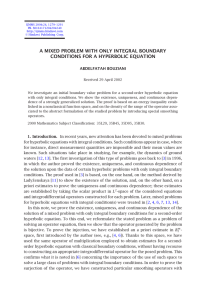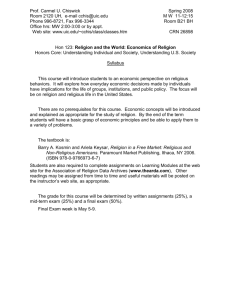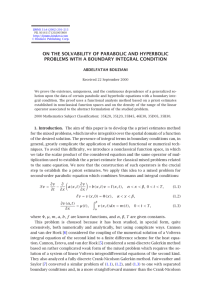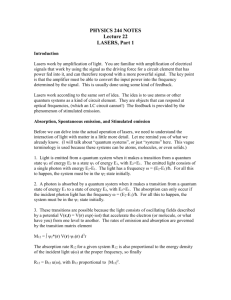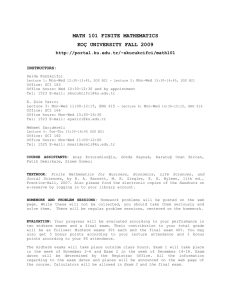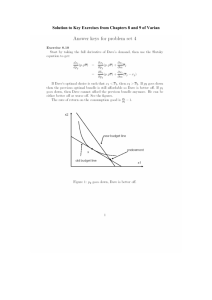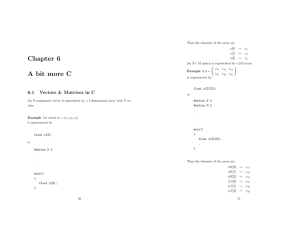ROTHE METHOD FOR A MIXED PROBLEM WITH AN DIFFUSION EQUATION
advertisement
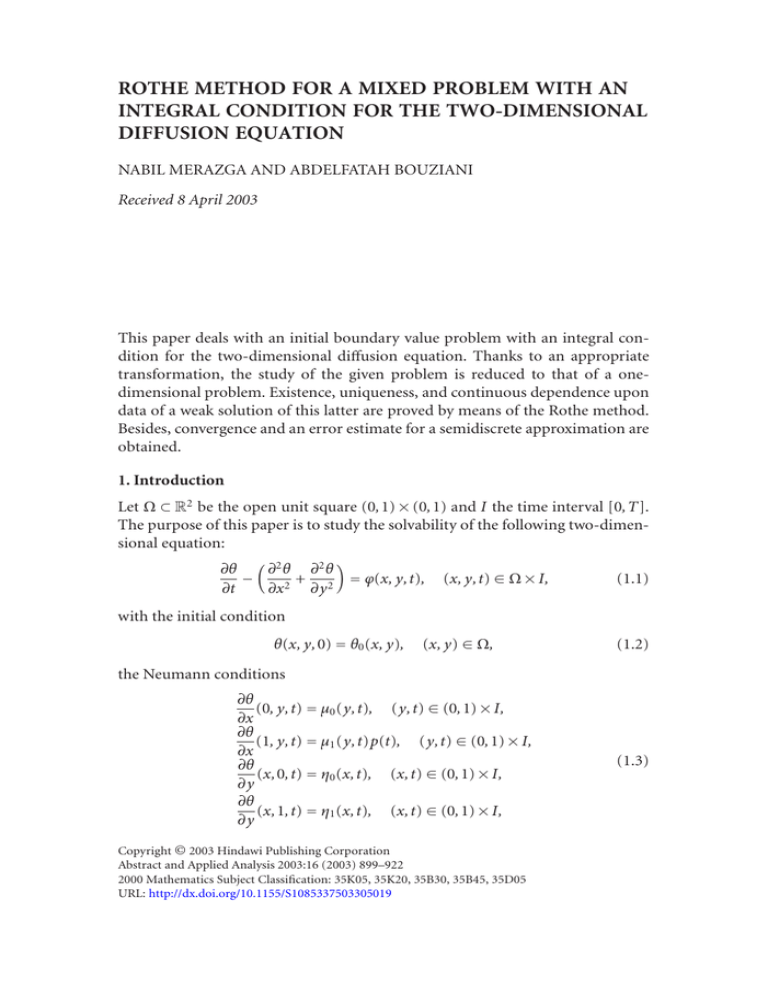
ROTHE METHOD FOR A MIXED PROBLEM WITH AN
INTEGRAL CONDITION FOR THE TWO-DIMENSIONAL
DIFFUSION EQUATION
NABIL MERAZGA AND ABDELFATAH BOUZIANI
Received 8 April 2003
This paper deals with an initial boundary value problem with an integral condition for the two-dimensional diffusion equation. Thanks to an appropriate
transformation, the study of the given problem is reduced to that of a onedimensional problem. Existence, uniqueness, and continuous dependence upon
data of a weak solution of this latter are proved by means of the Rothe method.
Besides, convergence and an error estimate for a semidiscrete approximation are
obtained.
1. Introduction
Let Ω ⊂ R2 be the open unit square (0,1) × (0,1) and I the time interval [0,T].
The purpose of this paper is to study the solvability of the following two-dimensional equation:
∂2 θ ∂2 θ
∂θ
−
+
= ϕ(x, y,t),
∂t
∂x2 ∂y 2
(x, y,t) ∈ Ω × I,
(1.1)
with the initial condition
θ(x, y,0) = θ0 (x, y),
(x, y) ∈ Ω,
(1.2)
the Neumann conditions
∂θ
(0, y,t) = µ0 (y,t), (y,t) ∈ (0,1) × I,
∂x
∂θ
(1, y,t) = µ1 (y,t)p(t), (y,t) ∈ (0,1) × I,
∂x
∂θ
(x,0,t) = η0 (x,t), (x,t) ∈ (0,1) × I,
∂y
∂θ
(x,1,t) = η1 (x,t), (x,t) ∈ (0,1) × I,
∂y
Copyright © 2003 Hindawi Publishing Corporation
Abstract and Applied Analysis 2003:16 (2003) 899–922
2000 Mathematics Subject Classification: 35K05, 35K20, 35B30, 35B45, 35D05
URL: http://dx.doi.org/10.1155/S1085337503305019
(1.3)
900
On the diffusion equation with an integral condition
and the integral condition
11
0
0
θ(x, y,t)dx d y = E(t),
t ∈ I,
(1.4)
where ϕ, θ0 , µ0 , µ1 , η0 , η1 , and E are given functions supposed to be sufficiently
regular, while the functions θ and p are unknown. Here, the time-dependent
parameter p is a control function.
The diffusion equation with an integral condition can model various physical phenomena in the context of chemical engineering, thermoelasticity, population dynamics, heat conduction processes, control theory, medical science,
life sciences, and so forth (see [5, 13] and the references therein). It is the reason for which such problems gained much attention in recent years, not only in
engineering but also in the mathematics community.
Most of the papers dealing with problems of this type were consecrated to
one-dimensional equations. The first work in this direction goes back to Cannon [6]. The author, with the aid of an equivalent integral equation, proved the
existence and uniqueness of the classical solution for a mixed problem with an
integral condition for the homogeneous one-dimensional heat equation.
In different approaches, mixed problems for second-order one-dimensional
parabolic equations which combine Dirichlet and integral conditions were investigated by Kamynin [18], Ionkin [15], Cannon and van der Hoek [9, 10],
Yurchuk [27], Benouar and Yurchuk [1], and Bouziani [5]. With regard to mixed
problems for one-dimensional heat equation with Neumann and integral conditions, Cannon et al. [8] and Cannon and Hoek [11] presented numerical
schemes based on finite difference method, Shi [26] established the well-posedness of the problem in a weighted fractional Sobolev space by means of the
Fourier transform and a variational formulation. For similar problems for more
general parabolic equations, we refer the reader to [2, 3, 4] in which the author
used the energy-integral method to study the solvability of the posed problems
in a strong sense.
As for two-dimensional homogeneous diffusion equations with an integral
condition, they have recently been treated in [7, 12, 13, 14].
Unlike all previous works, here we will prove the solvability of problem (1.1)–
(1.4) via approximation by the Rothe time-discretization method (also called
method of lines) after reduction to a one-space variable problem. This method is a convenient tool for both the theoretical and the numerical analysis of
the studied problem. Indeed, in addition to giving the first step towards a fully
discrete approximation scheme, it provides a constructive proof of the existence
of a unique exact solution to the investigated problem.
We note that since 1930, the Rothe method has been used several times to
solve a relatively broad complex of evolution problems by many authors (cf., e.g.,
[16, 17, 19, 20, 21, 22, 23, 24]). However, up to now, no evolution problem with
an integral condition over the spatial domain has been treated with the help of
N. Merazga and A. Bouziani 901
this method. So, our paper can be considered as a contribution to the extension
of the field of application of the aforesaid method to a new kind of problems.
The paper is organized as follows. In Section 2, we show that the investigation
of problem (1.1)–(1.4) can be reduced to that of the one-dimensional problem
(2.2)–(2.5) via a suitable transformation. We also give notation and assumptions
on data. In Section 3, we solve the time-discretized problems corresponding to
(2.2)–(2.5). Then, we derive some a priori estimates for the approximations and
establish convergence and existence result for problem (2.2)–(2.5) by considering firstly the case of homogeneous boundary conditions in Section 4 and secondly the nonhomogeneous case in Section 5.
2. Preliminaries
Exploiting an idea due to Dehghan [13], we reformulate problem (1.1)–(1.4) by
introducing a new unknown function u : (0,1) × I → R defined as follows:
u(x,t) =
1
0
θ(x, y,t)d y.
(2.1)
Then, we have to find a function u(x,t) such that
∂u ∂2 u
−
= f (x,t),
∂t ∂x2
u(x,0) = U0 (x),
1
0
(x,t) ∈ (0,1) × I,
(2.2)
x ∈ (0,1),
(2.3)
∂u
(0,t) = α(t),
∂x
t ∈ I,
(2.4)
u(x,t)dx = E(t),
t ∈ I,
(2.5)
where
f (x,t) =
U0 (x) =
α(t) =
1
0
ϕ(x, y,t)d y + η1 (x,t) − η0 (x,t),
1
0
1
0
θ0 (x, y)d y,
(2.6)
µ0 (y,t)d y.
Hence, once the solution of problem (2.2)–(2.5) is obtained, the value of p will
be obtained through the following formula:
(∂u/∂x)(1,t)
p(t) = 1
0 µ1 (y,t)d y
(2.7)
902
On the diffusion equation with an integral condition
1
provided that 0 µ1 (y,t)d y = 0 and u is smooth enough so that (∂u/∂x)(1,t)
makes sense. Afterwards, (2.7) will be used to find θ as the solution of problem
(1.1)–(1.3) with classical boundary conditions of Neumann type, whose investigation is standard numerically as well as analytically. Thus, the study of problem
(1.1)–(1.4) is simply reduced to that of problem (2.2)–(2.5). We then concentrate on this latter.
In the course of this paper, (·, ·) denotes the usual scalar product in L2 (0,1)
and · the corresponding norm. We denote by V the set of all φ ∈ L2 (0,1)
1
which fulfil 0 φ(x)dx = 0. Obviously, V is a closed linear subspace of L2 (0,1)
and, consequently, it is a Hilbert space for the L2 (0,1)-inner product. By H 2 (0,1)
we denote the usual second-order Sobolev space on (0,1) with norm · H 2 (0,1) .
Let X be a normed linear space. Then L2 (I,X) and L∞ (I,X) denote the sets of all
measurable functions v : I → X such that
v 2L2 (I,X) =
I
v(t)2 dt < ∞,
X
v L∞ (I,X) = esssup v(t)X < ∞,
(2.8)
t ∈I
respectively. By C(I,X) and C 0,1 (I,X) we denote the sets of continuous and Lipschitz continuous mapping v : I → X, respectively, where the first one is normed
by
v C(I,X) = max v(t)X ,
t ∈I
(2.9)
while by C 1,1 (I,X) we denote the subset of all v ∈ C 0,1 (I,X) such that dv/dt
∈ C 0,1 (I,X).
Moreover, our analysis requires the use of the nonclassical function space
B21 (0,1) introduced by Bouziani in [4] in the following way.
Let C0 (0,1) be the space of real continuous functions with compact support
in (0,1). Since such functions are Lebesgue-integrable, we can define on C0 (0,1)
the following inner product:
(u,v)B =
1
0
x u · x v dx,
(2.10)
x
where x v = 0 v(ξ)dξ for every fixed x ∈ (0,1). If · B denotes the corresponding norm, that is,
v B = (v,v)B = x v ,
(2.11)
the inequality
v 2B 1
v 2
2
(2.12)
N. Merazga and A. Bouziani 903
holds for every v ∈ C0 (0,1). This fact implies that C0 (0,1) is not complete for
(·, ·)B , otherwise it would be so too for (·, ·), which is not true. Denote by
B21 (0,1) the completion of C0 (0,1) for this new inner product. Then, from (2.12),
we readily see that L2 (0,1) is a subset of B21 (0,1) and, furthermore, the embedding L2 (0,1) → B21 (0,1) is continuous. Note that, by a density argument, inequality (2.12) can be extended to functions in L2 (0,1).
In the sequel, any function (x,t) ∈ (0,1) × I → g(x,t) ∈ R is automatically
identified with the associated abstract function t → g(t) defined from I into
some function space on (0,1) by setting g(t) : x ∈ (0,1) → g(x,t). The strong
∗
convergence is denoted by →, while and stand for the weak and weak∗
convergence, respectively. By C we denote a generic positive constant.
We formulate the following assumptions which are supposed to hold throughout the paper:
(A1 ) f (t) ∈ L2 (0,1) for each t ∈ I, and the Lipschitz condition
f (t) − f (t ) 1
B2 (0,1) l |t − t |
(2.13)
holds for arbitrary t,t ∈ I;
(A2 ) α,E ∈ C 1,1 (I, R);
(A3 ) U0 ∈ H 2 (0,1);
1
(A4 ) the compatibility conditions are (dU0 /dx)(0) = α(0) and 0 U0 (x)dx =
E(0).
We look for a weak solution in the following sense.
Definition 2.1. A function u : I → L2 (0,1) is called a weak solution to problem
(2.2)–(2.5) if the following conditions are satisfied:
(i) u ∈ L2 (I,L2 (0,1)) ∩ C(I,B21 (0,1));
(ii) u has a strong derivative du/dt ∈ L2 (I,B21 (0,1));
(iii) u fulfils the initial condition (2.3) and the integral condition (2.5);
(iv) let γ : (0,1) × I → R be the function
γ(x,t) = α(t) x −
1
+ E(t),
2
x ∈ (0,1), t ∈ I.
(2.14)
Then the integral identity
I
du
(t),v(t)
dt
=
I
B21 (0,1)
dt +
f (t),v(t)
I
u(t),v(t) dt
B21 (0,1) dt +
I
(2.15)
γ(t),v(t) dt
holds for all v ∈ L2 (I,V ).
We remark that due to (i), condition (iii) has sense, and by virtue of (i), (ii),
and assumption (A2 ), each term in the integral relation (iv) is well defined.
904
On the diffusion equation with an integral condition
3. Solvability of time-discretized problems
In order to solve problem (2.2)–(2.5) by the Rothe method, we subdivide the
time interval I by points t j = jh, j = 0,...,n, where h = T/n is a step time. Then,
for each n 1, problem (2.2)–(2.5) may be approximated by the following recurrent sequence of time-discretized problems.
Starting from
u0 = U0 ,
(3.1)
find, successively for j = 1,...,n, functions u j : (0,1) → R such that
δu j − u
j = f j ,
1
0
x ∈ (0,1),
(3.2)
u
j (0) = α j ,
(3.3)
u j (x)dx = E j ,
(3.4)
where δu j = (u j − u j −1 )/h, f j = f (x,t j ), α j = α(t j ), E j = E(t j ), and or stands
for the first or the second derivative with respect to x, respectively.
Because of the nonclassical condition (3.4), no standard method can be directly used to solve (3.2)–(3.4). Following an idea of [25], we consider the auxiliary Neumann boundary value problem for a second-order linear ordinary differential equation
1
h
1
h
−w j + w j = f j + w j −1 ,
x ∈ (0,1),
w
j (0) = α j ,
(3.5)
w
j (1) = λ j ,
where w0 = U0 and λ j is for the moment an arbitrary but fixed real number.
Since f j ∈ L2 (0,1), the Lax-Milgram lemma implies, as it is well known, the
existence and uniqueness of a solution w j ∈ H 2 (0,1) to the elliptic problem (3.5)
provided that the previous function w j −1 is already known. Thus, starting with
j = 1, this iterative procedure yields the following lemma.
Lemma 3.1. For all n 1 and for all λ j ∈ R, the auxiliary problems (3.5), j =
1,...,n, have unique solutions w j ∈ H 2 (0,1).
To emphasize the fact that w j depends on λ j , we will write w j (·,λ j ) instead of
w j . We now introduce, for each j = 1,...,n, the real function
Φ j λ j :=
1
0
w j x,λ j dx − E j .
(3.6)
N. Merazga and A. Bouziani 905
We remark that w j (·,λ j ) will be a solution to problem (3.2)–(3.4) if and only if
λ j is a real root of Φ j so that to establish the existence of a unique solution to
(3.2)–(3.4), it is sufficient to show that Φ j admits exactly one real root. We then
express w j (·,λ j ) in terms of λ j . For this, we introduce a new unknown function
v j by
w j x,λ j = v j (x) +
λj − αj 2
x + α j x,
2
(3.7)
then an easy computation shows that v j thus defined in (3.7) is a solution to the
problem
1
h
1
h
−v j + v j = f j + w j −1 + α j
1 2 1
1
x − x − 1 + λ j 1 − x2 ,
2h
h
2h
x ∈ (0,1),
v
j (0) = v
j (1) = 0.
(3.8)
Consequently, v j is the superposition of v j and v
j which are, respectively, solutions of the following problems
1
h
1
h
−
v
j + v j = f j + w j −1 + α j
1 2 1
x − x−1 ,
2h
h
x ∈ (0,1),
v
j (0) = v
j (1) = 0,
(3.9)
1
1
−
v j + v
j = λ j 1 − x2 ,
h
2h
x ∈ (0,1),
v
j (0) = v
j (1) = 0.
Obviously, only v
j depends on λ j . Applying the “variation of parameters method,” we easily obtain
v
j (x) = λ j
√
h
x
x2
√ cosh √
− ,
sinh 1/ h
j = 1,...,n,
h
2
√
h
x
√ cosh √
(3.10)
and substituting in (3.7), we get
1
w j x,λ j = v j (x) + α j x 1 − x + λ j
2
sinh 1/ h
h
(3.11)
so that the function (3.6) can be written in the form
Φ j λ j = hλ j +
1
0
v j (x) + α j x 1 −
x
2
dx − E j ,
(3.12)
906
On the diffusion equation with an integral condition
which proves that Φ j possesses a unique root λ j ∈ R given by
λj =
1
Ej −
h
1
0
v j (x) + α j x 1 −
x
2
dx .
(3.13)
Thus, we have just proved the following theorem.
Theorem 3.2. For all n 1 and for all j = 1,...,n, problem (3.2)–(3.4) admits a
unique solution u j in H 2 (0,1). Moreover,
u j (x) = w j x,λ j ,
x ∈ (0,1),
(3.14)
where w j (·,λ j ) is the solution of (3.5) with λ j given by (3.13).
We can now introduce the Rothe function u(n) : I → H 2 (0,1) obtained from
the functions u j by piecewise linear interpolation with respect to time
u(n) (t) = u j −1 + δu j t − t j −1 ,
t ∈ t j −1 ,t j , j = 1,...,n,
(3.15)
as well as the step function u(n) : I → H 2 (0,1) defined as follows:
(n)
u j ,
if t ∈ t j −1 ,t j , j = 1,...,n,
if t = 0.
u (t) =
U0 ,
(3.16)
The functions u(n) and u(n) are intended to be approximations of the solution of
our problem (2.2)–(2.5) in some suitable function space. To confirm this fact,
we derive some a priori estimates for u j and δu j .
We first work with the following special case.
4. Case of homogeneous boundary conditions
Throughout this section, we assume that
α(t) = E(t) = 0 ∀t ∈ I.
(4.1)
Then, for each j = 1,...,n, problem (3.2)–(3.4) is written as follows:
δu j − u
j = f j ,
1
0
x ∈ (0,1),
(4.2)
u
j (0) = 0,
(4.3)
u j (x)dx = 0,
(4.4)
N. Merazga and A. Bouziani 907
and assumption (A4 ) becomes
1
U0
(0) = 0,
0
U0 (x)dx = 0.
(4.5)
4.1. A priori estimates for the approximations
Lemma 4.1. There exists C > 0 such that, for all n 1, the solutions u j of the
discretized problems (4.2)–(4.4), j = 1,...,n, satisfy the estimates
u j C,
δu j B21 (0,1)
(4.6)
C.
(4.7)
Proof. As it will be seen later, the first estimate follows from the second one,
hence we begin by this latter.
Taking, for all j = 1,...,n, the inner product in B21 (0,1) of (4.2) with any φ ∈
V , we get
δu j ,φ
B21 (0,1) −
u
j ,φ
B21 (0,1)
= f j ,φ B21 (0,1) .
(4.8)
It follows from (4.3) that
u
j ,φ
B21 (0,1)
=
=
=
1
0
1
x u
j x φ dx
0
1
0
u
j (x) − u
j (0) x φ dx
(4.9)
u
j (x)x φ dx
so that the standard integration by parts leads to
u
j ,φ
since
1
0
B21 (0,1)
1
= u j (x)x φ|xx=
=0 −
1
0
u j φ dx = − u j ,φ
(4.10)
φ(x)dx = 0. Substituting into (4.8), we finally obtain
δu j ,φ
B21 (0,1) +
u j ,φ = f j ,φ
(4.11)
B21 (0,1)
for all φ ∈ V .
Consider the identity
δu1 ,φ
B21 (0,1) + h
δu1 ,φ = f1 ,φ
B21 (0,1) −
U0 ,φ
(4.12)
908
On the diffusion equation with an integral condition
which results from (4.11) with j = 1. Performing an integration by parts, we get
U0 ,φ =
1
0
U0 (x) x φ dx
1
= U0 (x)x φ|xx=
=0 −
=−
1
0
1
0
U0
(x)x φ dx
(4.13)
U0
(x)x φ dx,
but assumption (A3 ) and the first condition in (4.5) yield
x U0
= U0
(x)
∀x ∈ (0,1),
(4.14)
from which it follows that
U0 ,φ = −
1
0
x U0
x φ dx = − U0
,φ B21 (0,1) .
(4.15)
Substituting in the right-hand side of (4.12), (4.15) becomes
δu1 ,φ
B21 (0,1) + h
δu1 ,φ = f1 + U0
,φ
B21 (0,1) .
(4.16)
Since δu1 is an element of V in view of (4.4) with j = 1, the second condition
in (4.5), and assumption (A3 ), it may be employed as a test function in (4.16) to
get with the aid of Cauchy-Schwarz inequality
δu1 2 f1 1
U 1
δu1 1
+
h
+
0 B2 (0,1)
B2 (0,1)
B2 (0,1)
B2 (0,1) ,
δu1 2 1
(4.17)
hence
δu1 B21 (0,1)
f C(I,B21 (0,1)) + U0
B21 (0,1) .
(4.18)
Now we take the difference of the relations (4.11) and (4.11) with j replaced by
j − 1, j = 2,...,n, applied to the test function φ = δu j which is in V by virtue of
(4.4) and (4.4) with j replaced by j − 1; we have
δu j 2 1
B2 (0,1) +
1
u j − u j −1 2 = f j − f j −1 ,δu j 1
B2 (0,1) + δu j −1 ,δu j B21 (0,1) .
h
(4.19)
Applying Cauchy-Schwarz inequality and omitting the second term in the lefthand side, we obtain
δu j 2 1
B2 (0,1)
f j − f j −1 B21 (0,1) δu j B21 (0,1) + δu j −1 B21 (0,1) δu j B21 (0,1) .
(4.20)
N. Merazga and A. Bouziani 909
Hence, invoking assumption (A1 ), we have
δu j B21 (0,1)
lh + δu j −1 B21 (0,1)
(4.21)
so that, by an iterative procedure, we may arrive at
δu j B21 (0,1)
l( j − 1)h + δu1 B21 (0,1) .
(4.22)
Finally, in light of (4.18), we obtain
δu j B21 (0,1)
lT + f C(I,B21 (0,1)) + U0
B21 (0,1)
(4.23)
for every j = 1,...,n. This proves (4.7) with C = lT + f C(I,B21 (0,1)) + U0
B21 (0,1) .
Next, we majorize u j . The application of the formula
u j ,u j − u j −1 =
1 u j 2 − u j −1 2 + u j − u j −1 2
2
(4.24)
to (4.11) with φ = u j − u j −1 as test functions, j = 1,...,n, yields
2
2 1 2 2
1
1
hδu j B21 (0,1) + u j − u j −1 + u j = f j ,u j − u j −1 B21 (0,1) + u j −1 .
2
2
2
(4.25)
Omitting the first two terms in the left-hand side and using Cauchy-Schwarz
inequality, we obtain
2
u j 2 f j B21 (0,1)
u j − u j −1 B21 (0,1) +
u j −1 2 .
(4.26)
So, in consideration of (4.23), we have
2
u j 2h f C(I,B21 (0,1))
2
lT + f C(I,B21 (0,1)) + U0
B21 (0,1) + u j −1 .
(4.27)
Iterating this inequality, we may obtain
2
u j 2 jh f C(I,B21 (0,1))
2
2
lT + f C(I,B21 (0,1)) + U0
B21 (0,1) + U0 .
(4.28)
Hence, the estimate (4.6) follows with
C = 2T f C(I,B21 (0,1)) lT + f C(I,B21 (0,1)) + U0
B21 (0,1) + U0 ,
and so our proof is complete.
(4.29)
910
On the diffusion equation with an integral condition
As a consequence of Lemma 4.1 and the definition of u(n) and u(n) , we obtain
the following corollary.
Corollary 4.2. For all n 1, the functions u(n) and u(n) satisfy the estimates
(n) u (t) C,
(n) du
dt (t)
(n) u (t) C,
C
B21 (0,1)
(n)
u (t) − u(n) (t)
(n)
u (t) − u(n) (t )
(4.30)
for a.e. t ∈ I,
B21 (0,1)
B21 (0,1)
∀t ∈ I,
C
n
(4.31)
∀t ∈ I,
C |t − t |
(4.32)
∀t,t ∈ I.
(4.33)
Proof. Estimates (4.30) follow immediately from estimate (4.6) with the same
constant, whereas estimate (4.31) is an easy consequence of estimate (4.7), also
with the same constant, noting that we have
du(n)
(t) = δu j ,
dt
t ∈ t j −1 ,t j , 1 j n.
(4.34)
For estimate (4.32), it suffices to see that we have
u(n) (t) − u(n) (t) = t j − t δu j ,
t ∈ t j −1 ,t j , 1 j n,
(4.35)
and consequently,
(n)
u (t) − u(n) (t)
B21 (0,1)
h max δu j B21 (0,1)
∀t ∈ I.
1 j n
(4.36)
Hence, applying estimate (4.7), we get (4.32) with
C = T lT + f C(I,B21 (0,1)) + U0
B21 (0,1) .
(4.37)
Finally, using the inequality
(n)
u (t) − u(n) (t )
B21 (0,1)
t (n) du
ds (s)
t
B21 (0,1)
ds
,
which holds for all t,t ∈ I, we obtain (4.33) in view of estimate (4.31).
(4.38)
N. Merazga and A. Bouziani 911
4.2. Convergence and existence result. Define the step function f
L2 (0,1) by setting
f
(n)
fj,
(n)
:I→
if t ∈ t j −1 ,t j , j = 1,...,n,
(t) =
f0 , if t = 0.
(4.39)
Then, for all v ∈ L2 (I,V ), the variational equation (4.11) may be written in terms
(n)
of u(n) , u(n) , and f as follows:
du(n)
(t),v(t)
dt
B21 (0,1)
(n)
+ u(n) (t),v(t) = f
(t),v(t)
B21 (0,1)
for a.e. t ∈ I.
(4.40)
Integrating this formula over I, we obtain the following approximation: scheme
I
du(n)
(t),v(t)
dt
=
I
f
(n)
B21 (0,1)
dt +
(t),v(t)
I
B21 (0,1)
dt
u(n) (t),v(t) dt
(4.41)
∀v ∈ L2 (I,V ),
and we propose to establish the convergence of it to the weak formulation of
problem (2.2)–(2.5), given by (2.15). The results of Corollary 4.2 are the basis
for the following convergence assertions for the Rothe approximations.
Theorem 4.3. There exists a function u ∈ L2 (I,V ) ∩ C(I,B21 (0,1)) with du/dt ∈
L2 (I,B21 (0,1)) and subsequences {u(nk ) }k ⊆ {u(n) }n , {u(nk ) }k ⊆ {u(n) }n such that
u(nk ) u
in L2 (I,V ),
(4.42)
u(nk ) u
in L2 (I,V ),
(4.43)
du
du(nk )
dt
dt
in L2 I,B21 (0,1) .
(4.44)
Proof. Estimates (4.30) imply the uniform boundedness of {u(n) }n and {u(n) }n
in L2 (I,V ) with respect to n. Therefore, by extracting some subsequences {u(nk ) }k
and {u(nk ) }k , they converge in the weak topology to some functions u and u in
L2 (I,V ), as k → ∞, respectively. We show that u coincides with u. Since V B21 (0,1), we have also
2
u(nk ) u in L2 I,B21 (0,1) ,
(4.45)
u(nk ) u in L I,B21 (0,1) .
(4.46)
912
On the diffusion equation with an integral condition
From the equality u(nk ) − u = (u(nk ) − u(nk ) ) + (u(nk ) − u), it follows by means of
(4.32) that
(nk )
u
− u,v L2 (I,B1 (0,1)) u(nk ) − u(nk ) L2 (I,B1 (0,1)) v L2 (I,B21 (0,1))
2
2
+ u(nk ) − u,v L2 (I,B1 (0,1)) 2
(4.47)
C
v L2 (I,B21 (0,1)) + u(nk ) − u,v L2 (I,B21 (0,1)) nk
for all v ∈ L2 (I,B21 (0,1)), so that by passing to the limit as k → ∞, we get, in view
of (4.45), |(u(nk ) − u,v)L2 (I,B21 (0,1)) | → 0, that is, u(nk ) u in L2 (I,B21 (0,1)); consequently u = u holds. Hence, we obtain (4.43). On the other hand, according
to (4.31), {du(n) /dt }n is bounded in L2 (I,B21 (0,1)). Thus, there is a subsequence
{du(nk ) /dt }k and some w ∈ L2 (I,B21 (0,1)) such that
du(nk )
w
dt
in L2 I,B21 (0,1) .
(4.48)
It remains to show that w equals du/dt in L2 (I,B21 (0,1)). For this, we consider
the equality
u
(nk )
(t) − U0 =
t
0
du(nk ) (s)
ds
ds
∀t ∈ I,
(4.49)
which ensues from the construction of u(n) and (3.1). It follows due to (4.45)
and (4.48) that [23, page 207]
u(t) = U0 +
t
0
w(s)ds ∀t ∈ I,
(4.50)
(Bochner integral in B21 (0,1)) which implies [16, Lemmas 1.3.2(iii) and 1.3.6(i)]
that u is in C(I,B21 (0,1)) and even (strongly) differentiable a.e. in I with du/dt =
w in L2 (I,B21 (0,1)), which was to be shown.
Now we are prepared to state an existence theorem.
Theorem 4.4. The limit function u is the unique weak solution to problem (2.2)–
(2.5) in the case of (4.1) in the sense of Definition 2.1.
Proof. Note that in light of what precedes, we have u ∈ L2 (I,V ) ∩ C(I,B21 (0,1)),
and consequently u fulfils the integral condition (2.5) with E(t) ≡ 0 since u(t)
belongs to V for a.e. t ∈ I. Moreover, according to (4.50), u(0) = U0 holds, so
the initial condition (2.3) is also fulfilled. To see that u obeys the weak formulation of problem (2.2)–(2.5), we will show that approximation scheme (4.41)
approaches, for the subsequence {nk }k ⊆ {n}n , the integral relation (2.15) with
N. Merazga and A. Bouziani 913
γ(t) ≡ 0. We note that assumption (A1 ) implies that
(n)
f (t) − f (t)
B21 (0,1)
C
n
a.e. in I,
(4.51)
from which we deduce easily that
(n)
f − f
L2 (I,B21 (0,1))
C
−→ 0 as n −→ ∞,
n
(4.52)
that is,
f
(n)
in L2 I,B21 (0,1) .
−→ f
(4.53)
Finally, a limiting process n = nk → ∞ in approximation scheme (4.41) by
means of the convergence properties (4.43), (4.44), and (4.53) immediately
yields
I
du
(t),v(t)
dt
=
B21 (0,1)
I
dt +
f (t),v(t)
I
u(t),v(t) dt
(4.54)
B21 (0,1) dt
2
∀v ∈ L (I,V ).
Thus, u weakly solves problem (2.2)–(2.5). The uniqueness can be shown in a
standard way. Indeed, if u∗ and u∗∗ are two weak solutions of (2.2)–(2.5), then
the difference u := u∗ − u∗∗ satisfies
I
du
(t),v(t)
dt
B21 (0,1)
dt +
u(t),v(t) dt = 0 ∀v ∈ L2 (I,V );
I
(4.55)
besides, u(0) = 0 holds.
For every fixed t 0 ∈ I, we define
u(t),
v(t) =
0,
0 t t0 ,
t 0 < t T,
(4.56)
which obviously belongs to L2 (I,V ). Using (4.56) as a test function in the last
integral relation, we obtain
t0 0
du
(t),u(t)
dt
t0
B21 (0,1)
dt +
0
u(t)2 dt = 0
(4.57)
914
On the diffusion equation with an integral condition
or
t0 0
du
(t),u(t)
dt
B21 (0,1)
dt 0
(4.58)
so that, in view of the formula (d/dt)u(t)2B21 (0,1) = 2((du/dt)(t),u(t))B21 (0,1) and
due to u(0) = 0, we get u(t 0 )2B21 (0,1) 0. Consequently, u(t) = 0 for all t ∈ I,
meaning that u∗ = u∗∗ , that is, uniqueness, which achieves the proof.
Remark 4.5. As a consequence of the uniqueness of the weak solution of (2.2)–
(2.5), we conclude, by the usual argument, that the convergence assertions for
the Rothe approximations in Theorem 4.3 hold for the whole sequence {u(n) }n .
Actually, we may state the following uniform convergence assertion.
Theorem 4.6. The sequence {u(n) }n converges in the norm of the space C(I,B21 (0,
1)) to the solution u of (2.2)–(2.5), and the error estimate
(n)
u − u C(I,B21 (0,1))
Ch1/2
(4.59)
takes place with some positive constant.
Proof. We prove that {u(n) }n is a Cauchy sequence in C(I,B21 (0,1)). For this purpose, we estimate the difference u(n) − u(m) , where u(n) and u(m) are Rothe approximations corresponding to the step lengths hn = T/n and hm = T/m, respectively. Estimating the identity
u(n) (t),v(t) = f
(n)
(t) −
du(n)
(t),v(t)
dt
a.e. in I, ∀v ∈ L2 (I,V ),
B21 (0,1)
(4.60)
which results from (4.40), we obtain, owing to (4.31),
(n) (n)
u (t),v(t) f (t)
C1 v(t)
(n) du
+
(t)
B 1 (0,1) dt
2
B21 (0,1)
B21 (0,1)
v(t)
B21 (0,1)
(4.61)
2
a.e. in I, ∀v ∈ L (I,V ),
with C1 = lT + 2 f C(I,B21 (0,1)) + U0
B21 (0,1) . Now we take the difference of the
relations (4.40) and (4.40) written for m with m = n and test it with v = u(n) −
u(m) (∈ L2 (I,V )). This yields
d (n)
u (t) − u(m) (t) ,u(n) (t) − u(m) (t)
dt
B21 (0,1)
+ u(n) (t) − u(m) (t),u(n) (t) − u(m) (t)
(n)
(m)
= f (t) − f (t),u(n) (t) − u(m) (t)
B21 (0,1)
(4.62)
a.e. in I,
N. Merazga and A. Bouziani 915
or after some rearrangement,
(n)
2
1 d
(m)
u(n) (t) − u(m) (t)2 1
(t)
B2 (0,1) + u (t) − u
2 dt
= u(n) (t) − u(m) (t),u(n) (t) − u(m) (t) − u(n) (t) + u(m) (t)
(n)
(m)
+ f (t) − f (t),u(n) (t) − u(m) (t) 1
a.e. in I.
(4.63)
B2 (0,1)
Ignoring the second term in the left-hand side which is clearly positive, we estimate, with the aid of (4.61), (4.30), and (4.32),
1 d
u(n) (t) − u(m) (t)2 1
B2 (0,1)
2 dt
2C1 u(n) (t) − u(n) (t)B21 (0,1) + u(m) (t) − u(m) (t)B21 (0,1)
+f
(n)
(t) − f
(m)
(t)
B21 (0,1)
(n)
u (t) − u(m) (t)
(n)
(m)
2C12 hn + hm + 2C2 f (t) − f (t)
(4.64)
B21 (0,1)
B21 (0,1)
with
2
C2 = 2T f C(I,B21 (0,1)) lT + f C(I,B21 (0,1)) + U0
B21 (0,1) + U0 .
(4.65)
Assume now that n < m, then hm < hn . For all t ∈ (0,T], there exist two integers
k = k(n) and i = i(m) such that t ∈ (tk−1 ,tk ] ∩ (ti−1 ,ti ]. Hence, from assumption
(A1 ), it follows that
(n)
(m)
f (t) − f (t)
B21 (0,1)
= f tk − f ti B21 (0,1) ltk − ti .
(4.66)
Consequently,
(n)
(m)
f (t) − f (t)
B21 (0,1)
lhn
∀t ∈ I.
(4.67)
Substituting into (4.64) and integrating the resulting inequality over (0,t) ⊂ I,
invoking the fact that u(n) (0) = u(m) (0) = U0 , we get
(n)
u (t) − u(m) (t)2 1
B2 (0,1)
4 C12 hn + hm + C2 lhn t
4 C12 hn + hm + C2 lhn T
(4.68)
so that
(n)
u − u(m) C(I,B21 (0,1))
2 T C12 hn + hm + C2 lhn .
(4.69)
916
On the diffusion equation with an integral condition
This implies that {u(n) }n is a Cauchy sequence in the Banach space C(I,B21 (0,1)),
and hence it converges in the norm of this latter to some function which is not
other than u. Besides, passing
to the limit m → ∞ in (4.69), we obtain the desired
error estimate with C = 2 T(C12 + C2 l) and h = hn , which finishes the proof.
Now, we present some additional properties of the obtained solution.
Theorem 4.7. For the solution u of (2.2)–(2.5), the following assertions hold:
(i) u ∈ C 0,1 (I,B21 (0,1)) ∩ L∞ (I,V ) and du/dt ∈ L∞ (I,B21 (0,1));
(ii) u depends continuously upon data f and U0 ; namely,
uC(I,B21 (0,1)) C f C(I,B21 (0,1)) + U0 H 2 (0,1) ,
(4.70)
where C > 0 depends neither on f nor on U0 .
Proof. The Lipschitz continuity of u follows immediately from (4.33) and convergence result from Theorem 4.6. From this fact, we have (du/dt)(t)B21 (0,1) C for a.a. t ∈ I since u is strongly differentiable, that is, du/dt ∈ L∞ (I,B21 (0,1)).
Since the space L∞ (I,V) is the dual space to the separable Banach space L1 (I,V),
every bounded set in L∞ (I,V ) is compact in the weak∗ topology. From the first
estimate in (4.30), we infer that
max u(n) (t) C,
t ∈I
uniformly on n.
(4.71)
Consequently, there exist ω ∈ L∞ (I,V ) and a subsequence {u(nk ) }k ⊆ {u(n) }n
∗
such that u(nk ) ω in L∞ (I,V ), from which it follows also that u(nk ) ω in
L2 (I,V ) ⊃ L∞ (I,V ), and hence due to (4.42), u = ω is true. Thus u ∈ L∞ (I,V ).
With regard to Theorem 4.7(ii), the first estimate in (4.30) and convergence
result from Theorem 4.6 yield
uC(I,B21 (0,1)) 1 2
T f C(I,B21 (0,1)) lT + f C(I,B21 (0,1)) + U0
B21 (0,1) + U0 ,
2
(4.72)
where (2.12) has been used. This shows that the mapping ( f ,U0 ) → u from
C(I,B21 (0,1)) × H 2 (0,1) into C(I,B21 (0,1)) is bounded on the unit ball ( f ,U0 )
:= f C(I,B21 (0,1)) + U0 H 2 (0,1) 1 and hence continuous since it is linear. Ac!
cordingly, the inequality (4.70) follows for C = T(lT + 1) + 1/2, which expresses
the continuous dependence of u on data, so the proof is complete.
At the end of this subsection, we summarize all the obtained results into the
following theorem.
N. Merazga and A. Bouziani 917
Theorem 4.8. Let assumptions (A1 ), (A3 ), and (A4 ) be fulfilled. Then, problem
(2.2)–(2.5) with homogeneous boundary conditions has a unique weak solution
u in the sense of Definition 2.1 with additional regularity u ∈ C 0,1 (I,B21 (0,1)) ∩
L∞ (I,V ) and du/dt ∈ L∞ (I,B21 (0,1)).
The sequence of Rothe functions converges to the solution u in the following
sense:
u(n) u
in L2 (I,V ),
u(n) −→ u
du(n)
dt
in C I,B21 (0,1) ,
du
dt
(4.73)
in L2 I,B21 (0,1) ,
as n → ∞.
Moreover, u depends continuously on the right-hand side of (2.2) and on the
initial function.
5. Case of nonhomogeneous boundary conditions
We now return to the general case without assuming (4.1). Then, instead of
(4.11), we have
δu j ,φ
B21 (0,1)
+ u j ,φ = f j ,φ
B21 (0,1)
− αj
1
0
x φ dx
∀φ ∈ V,
(5.1)
but since, here, u j and δu j are not in V , they are not admissible test functions for
the aforesaid identity, which hinders obtaining an analog of the crucial a priori
estimate (4.7) and on the basis of which convergence and existence results are
established in the previous case. However, in order to exploit the results of the
preceding section, we introduce the transform
u j = u
j + γ j ,
j = 0,...,n,
(5.2)
where
1
+ Ej
γ j (x) = α j x −
2
∀x ∈ (0,1), j = 0,...,n.
(5.3)
1
Then, noticing that γ
j (0) = α j and 0 γ j (x)dx = [α j (x2 /2 − x/2) + E j x]xx==10 = E j ,
problems (3.1)–(3.4) are reduced as follows:
δ u
j − u
j = f j − δγ j ,
u
j (0) = 0,
1
0
u
j (x)dx = 0,
j = 1,...,n,
u
0 = U0 − γ0 ,
(5.4)
918
On the diffusion equation with an integral condition
where δγ j = (γ j − γ j −1 )/h. Obviously, the obtained problems are exactly those
treated in Section 4 with U0 − γ0 and f j − δγ j instead of U0 and f j , respectively.
Therefore, recalling the function γ defined in (2.14), they are seen to be the timediscretized problems corresponding to the following evolution problem:
∂u
∂2 u
−
= f in (0,1) × I,
∂t ∂x2
(5.5)
u
(x,0) = U
0 (x),
x ∈ (0,1),
(5.6)
t ∈ I,
(5.7)
∂u
(0,t) = 0,
∂x
1
0
u
(x,t)dx = 0,
t ∈ I,
(5.8)
U
0 = U0 − γ0 .
(5.9)
where
f
= f −
dγ
,
dt
It is easy to check, in virtue of assumption (A2 ), that dγ/dt ∈ C 0,1 (I,B21 (0,1)).
Hence, the same holds for f
thanks to assumption (A1 ). Furthermore, owing
to assumptions (A3 ) and (A4 ), it follows that U
0 ∈ H 2 (0,1), U
0
(0) = 0, and
1
0 U0 (x)dx = 0. Thus, since all assumptions of the preceding section are fulfilled, Theorem 4.8 is valid for problem (5.5)–(5.8). This fact allows us to state
our main result
Theorem 5.1. Under assumptions (A1 ), (A2 ), (A3 ), and (A4 ), problem (2.2)–(2.5)
admits a unique weak solution u in the sense of Definition 2.1 having the following
additional properties:
(i) u ∈ C 0,1 (I,B21 (0,1)) ∩ L∞ (I,L2 (0,1)) and du/dt ∈ L∞ (I,B21 (0,1));
(ii) the sequence of Rothe functions (3.15) converges to u in the following sense:
u(n) u in L2 I,L2 (0,1) ,
u(n) −→ u
du(n)
dt
du
dt
in C I,B21 (0,1) ,
2
(5.10)
in L I,B21 (0,1) ,
as n → ∞;
(iii) u depends continuously on the right-hand side of (2.2) and on the initial
and boundary data; namely, a constant K > 0 exists such that
uC(I,B21 (0,1)) K f C(I,B21 (0,1)) + U0 H 2 (0,1) + αC1 (I,R) + EC1 (I,R) .
(5.11)
N. Merazga and A. Bouziani 919
Proof. Consider the function
u = u
+ γ.
(5.12)
Since both u
and γ belong to L2 (I,L2 (0,1)) ∩ C(I,B21 (0,1)), the same holds for
u. Similarly, we infer that du/dt = du
/dt + dγ/dt is in L2 (I,B21 (0,1)). Invoking
the second relation in (5.9), that is, U
0 = U0 − γ0 , we see that u(0) = U0 , and
from (5.8), it follows that
1
0
u(x,t)dx =
1
0
γ(x,t)dx =
1
0
α(t) x −
1
+ E(t) dx = E(t).
2
(5.13)
Moreover, performing the substitutions f
= f − dγ/dt and (5.12) in the integral
identity (4.54) written for u
, we get
I
du
(t),v(t)
dt
=
I
B21 (0,1)
dt +
f (t),v(t)
I
u(t),v(t) dt
B21 (0,1) dt +
I
(5.14)
γ(t),v(t) dt
for all v ∈ L2 (I,V ). Thus, u defined in (5.12) turns out to be a weak solution of
problem (2.2)–(2.5). Besides, since the weak solution of (5.5)–(5.8) is unique, so
is the solution of (2.2)–(2.5).
Theorem 5.1(i) is an immediate consequence of the regularity properties of
u
and the fact that γ ∈ C 0,1 (I,B21 (0,1)) ∩ L∞ (I,L2 (0,1)) which results from assumption (A2 ).
Before checking the convergence properties in Theorem 5.1(ii), we remark
u(n) }n , corresponding to problems (2.2)–
that the Rothe sequences {u(n) }n and {
(2.5) and (5.5)–(5.8), respectively, are connected by the formula
u(n) (t) = u
(n) (t) + γ(n) (t) ∀t ∈ I,
(5.15)
where
γ(n) (t) = γ j −1 + δγ j t − t j −1 ,
t ∈ t j −1 ,t j , j = 1,...,n.
(5.16)
But, for all t ∈ [t j −1 ,t j ], j = 1,...,n, we have
γ(t) − γ(n) (t) γ(t) − γ t j −1 + δγ j t − t j −1 2C1 t − t j −1 C
,
n
(5.17)
920
On the diffusion equation with an integral condition
√
where C1 = (1/ 12)supt∈I |(dα/dt)(t)| + supt∈I |(dE/dt)(t)|, and C = 2C1 T.
Therefore,
sup γ(t) − γ(n) (t) t ∈I
C
−→ 0 for n −→ ∞,
n
(5.18)
that is, γ(n) → γ in C(I,L2 (0,1)) ⊂ C(I,B21 (0,1)) so that, according to the converu(n) }n , we conclude that u is the weak limit in
gence properties of the sequence {
2
2
L (I,L (0,1)) and the strong limit in C(I,B21 (0,1)) to the Rothe sequence {u(n) }n .
On the other hand, since
dγ(n)
(t) = δγ j ,
dt
t ∈ t j −1 ,t j , j = 1,...,n,
(5.19)
it follows that (dγ(n) /dt)(t)B21 (0,1) C for all t ∈ I, which implies that the sequence {dγ(n) /dt }n is bounded in L2 (I,B21 (0,1)) and hence contains a subsequence {dγ(nk ) /dt }k converging weakly to some function in L2 (I,B21 (0,1)), which
is shown to be equal to the function dγ/dt in a similar way as in the proof of
Theorem 4.3. Thus, since du
(n) /dt du
/dt in L2 (I,B21 (0,1)), we get
du(nk ) du
(nk ) dγ(nk )
du
dγ du
=
=
+
+
dt
dt
dt
dt dt
dt
in L2 I,B21 (0,1) .
(5.20)
However, from the uniqueness of the weak solution of problem (2.2)–(2.5), it
follows in the usual way that the entire sequence {du(n) /dt }n converges weakly
to du/dt in L2 (I,B21 (0,1)).
As for Theorem 5.1(iii), using (5.9) and (5.12), inequality (4.70) written for
u
yields
uC(I,B21 (0,1))
"
dγ dt C f C(I,B21 (0,1)) + C(I,L2 (0,1))
#
+ U0 H 2 (0,1) + γ0 H 2 (0,1)
(5.21)
+ γC(I,L2 (0,1)) .
An easy computation leads to
γ(t) =
γ(t)
H 2 (0,1)
=
2 2
1
1 α(t) + E(t) √ α(t) + E(t),
12
12
2 2
13 α(t) + E(t) 12
13 α(t) + E(t),
12
$ 2 2
dγ %
(t) = & 1 dα (t) + dE (t) √1
dt 12 dt
dt
12
dα dE (t) + dt dt (t),
(5.22)
N. Merazga and A. Bouziani 921
for every fixed t ∈ I, from which it follows that
1
αC(I,R) + EC(I,R) ,
12
γC(I,L2 (0,1)) √
γC(I,H 2 (0,1)) dγ dt 13
αC(I,R) + EC(I,R) ,
12
(5.23)
dE 1 dα √ +
.
dt dt 2
12
C(I,L (0,1))
C(I,R)
C(I,R)
Accordingly, substituting in (5.21), we finally get estimation (5.11) with K =
2max(C, 1). So we complete the proof.
References
[1]
[2]
[3]
[4]
[5]
[6]
[7]
[8]
[9]
[10]
[11]
[12]
N.-E. Benouar and N. I. Yurchuk, A mixed problem with an integral condition for
parabolic equations with a Bessel operator, Differentsial’nye Uravneniya 27 (1991),
no. 12, 2094–2098 (Russian).
A. Bouziani, Solution forte d’un problème mixte avec condition intégrale pour une classe
d’équations paraboliques [Strong solutions of a mixed problem with an integral condition for a class of parabolic equations], Maghreb Math. Rev. 6 (1997), no. 1, 1–17
(French).
, On a class of parabolic equations with a nonlocal boundary condition, Acad.
Roy. Belg. Bull. Cl. Sci. (6) 10 (1999), no. 1-6, 61–77.
, On the solvability of parabolic and hyperbolic problems with a boundary integral condition, Int. J. Math. Math. Sci. 31 (2002), no. 4, 201–213.
, On the weak solution of a three-point boundary value problem for a class
of parabolic equations with energy specification, Abstr. Appl. Anal. 2003 (2003),
no. 10, 573–589.
J. R. Cannon, The solution of the heat equation subject to the specification of energy,
Quart. Appl. Math. 21 (1963), 155–160.
J. R. Cannon, Y. P. Lin, and A. L. Matheson, The solution of the diffusion equation
in two space variables subject to the specification of mass, Appl. Anal. 50 (1993),
no. 1-2, 1–15.
J. R. Cannon, S. Pérez Esteva, and J. van der Hoek, A Galerkin procedure for the diffusion equation subject to the specification of mass, SIAM J. Numer. Anal. 24 (1987),
no. 3, 499–515.
J. R. Cannon and J. van der Hoek, The existence of and a continuous dependence result
for the solution of the heat equation subject to the specification of energy, Boll. Un.
Mat. Ital. Suppl. (1981), no. 1, 253–282.
, An implicit finite difference scheme for the diffusion equation subject to the
specification of mass in a portion of the domain, Numerical Solutions of Partial
Differential Equations (Parkville, 1981) (J. Noye, ed.), North-Holland, Amsterdam, 1982, pp. 527–539.
, Diffusion subject to the specification of mass, J. Math. Anal. Appl. 115 (1986),
no. 2, 517–529.
M. Dehghan, Implicit locally one-dimensional methods for two-dimensional diffusion
with a non-local boundary condition, Math. Comput. Simulation 49 (1999), no. 45, 331–349.
922
[13]
[14]
[15]
[16]
[17]
[18]
[19]
[20]
[21]
[22]
[23]
[24]
[25]
[26]
[27]
On the diffusion equation with an integral condition
, A finite difference method for a non-local boundary value problem for twodimensional heat equation, Appl. Math. Comput. 112 (2000), no. 1, 133–142.
, Fully explicit finite-difference methods for two-dimensional diffusion with an
integral condition, Nonlinear Anal., Ser. A: Theory Methods 48 (2002), no. 5, 637–
650.
N. I. Ionkin, The solution of a certain boundary value problem of the theory of heat
conduction with a nonclassical boundary condition, Differencial’nye Uravnenija 13
(1977), no. 2, 294–304 (Russian).
J. Kačur, Method of Rothe in Evolution Equations, Teubner-Texte zur Mathematik,
vol. 80, BSB B. G. Teubner Verlagsgesellschaft, Leipzig, 1985.
J. Kačur and R. van Keer, On the numerical solution of semilinear parabolic problems
in multicomponent structures with Volterra operators in the transmission conditions
and in the boundary conditions, Z. Angew. Math. Mech. 75 (1995), no. 2, 91–103.
L. I. Kamynin, A boundary value problem in the theory of heat conduction with nonclassical boundary conditions, Ž. Vyčisl. Mat. i Mat. Fiz. 4 (1964), no. 6, 1006–1024
(Russian).
T. Nagasawa and S. Omata, Discrete Morse semiflows of a functional with free boundary, Adv. Math. Sci. Appl. 2 (1993), no. 1, 147–187.
T. Nagasawa and A. Tachikawa, Existence and asymptotic behavior of weak solutions to
strongly damped semilinear hyperbolic systems, Hokkaido Math. J. 24 (1995), no. 2,
387–405.
V. Pluschke, Local solutions to quasilinear parabolic equations without growth restrictions, Z. Anal. Anwendungen 15 (1996), no. 2, 375–396.
V. Pluschke and F. Weber, The local solution of a parabolic-elliptic equation with a nonlinear Neumann boundary condition, Comment. Math. Univ. Carolin. 40 (1999),
no. 1, 13–38.
K. Rektorys, The Method of Discretization in Time and Partial Differential Equations,
Mathematics and Its Applications, vol. 4, D. Reidel Publishing, Dordrecht, 1982.
E. Rothe, Zweidimensionale parabolische Randwertaufgaben als Grenzfall eindimensionaler Randwertaufgaben, Math. Ann. 102 (1930), 650–670 (German).
M. P. Sapagovas and R. Yu. Chegis, On some boundary value problems with a nonlocal condition, Differential Equations 23 (1987), no. 7, 858–863, translation from
Differentsial’nye Uravneniya 23 (1987), no. 7, 1268–1274.
P. Shi, Weak solution to an evolution problem with a nonlocal constraint, SIAM J. Math.
Anal. 24 (1993), no. 1, 46–58.
N. I. Yurchuk, A mixed problem with an integral condition for some parabolic equations, Differentsial’nye Uravneniya 22 (1986), no. 12, 2117–2126 (Russian).
Nabil Merazga: Département de Mathématiques, Centre Universitaire Larbi Ben M’hidi,
Oum El Bouagui 04000, Algeria
E-mail address: nabil.merazga@caramail.com
Abdelfatah Bouziani: Département de Mathématiques, Centre Universitaire Larbi Ben
M’hidi, Oum El Bouagui 04000, Algeria
E-mail address: af bouziani@hotmail.com

